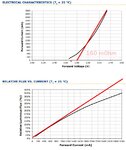ArminVanBuuren
Member level 3
Hello,
I am highly interested in this light:
**broken link removed**
However, finding CREE's XML T6 specifications, the typical voltage is only 3.35v:
**broken link removed**
The seller states that voltage input is 8.4V & includes such battery to it.
I have searched eBay & a lot of other ("more official") sites and they also offer an 8.4V battery pack for a single CREE XML T6 diode.
Would not it burn immediatelly?
Thank you.
I am highly interested in this light:
**broken link removed**
However, finding CREE's XML T6 specifications, the typical voltage is only 3.35v:
**broken link removed**
The seller states that voltage input is 8.4V & includes such battery to it.
I have searched eBay & a lot of other ("more official") sites and they also offer an 8.4V battery pack for a single CREE XML T6 diode.
Would not it burn immediatelly?
Thank you.

